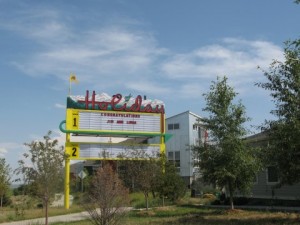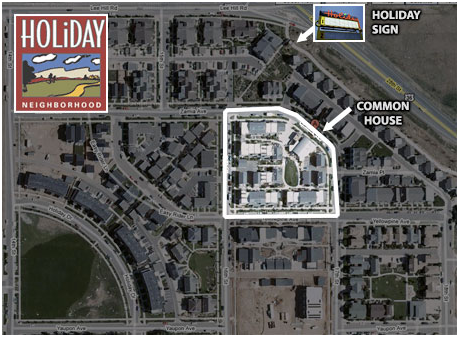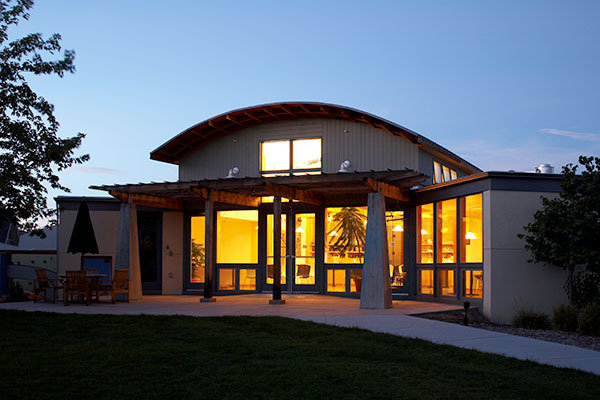Last month, I reflected on the wonderful neighborhoods I’ve been fortunate to call home over the last 20+ years. In that post, I mentioned a great film, Designing a Great Neighborhood. It tells the story of my present neighborhood – North Boulder’s Holiday Neighborhood – and focuses in particular on the development of the Wild Sage Cohousing Community, where my husband Jim and I live.
The film can be streamed on Netflix. It runs 54 minutes, and I hope you’ll take a look at it yourself. I’ll share a few highlights here (to whet your appetite!).

The old Holiday Drive-in Sign (complete with the "Congratulations Jim and Linda" message that was displayed when Jim and I got married!).
The documentary, made by cohousing enthusiast, writer and filmmaker Dave Wann, looks at the 330-home neighborhood known as Holiday – so named for the drive-in movie theater that formerly occupied the site’s 27 acres. Adjectives used to describe Holiday include “sustainable,” “affordable,” “diverse,” “lively,” “walkable,” “pedestrian-oriented.” Having lived here for nearly five years, I can testify to the accuracy of these descriptors!
Cindy Brown, co-director of Boulder Housing Partners and master site planner for the Holiday Neighborhood (and now author of the forthcoming The Girl’s Guide to Swagger), describes the history of the development:
The site was acquired by the City of Boulder in 1997, and the city had a vision for what this site might be. There was at the time a ‘big box’ – a Price Club – that wanted to buy this and locate there. But the city decided that they had a different vision for this area, that it would be a smaller scale, that there would be neighborhood businesses and multi-family and single-family, all oriented around a central park.
The neighborhood, says Brown, includes permanently affordable housing units, neighborhood businesses (including offices), live/work units (perhaps with an artist’s studio downstairs and living quarters upstairs), multi-family townhouses, single-family or duplex units. Thus, says Brown, “a rich variety of different types of homes and income levels [are] represented across the site.” “Some really nice features,” she adds, “are a park at the heart – this is a two-acre park that the City of Boulder will own and manage. And there’s a pedestrian walkway that gathers everything up, a community garden, and then [a] buffer zone.” Also included in the neighborhood are businesses that cater to leisure time, including coffee shops with indoor and outdoor seating, an Italian restaurant, a gourmet bistro, a fitness center, a pizza shop, and a bicycle shop – all within a five- or ten-minute walk from most homes. George Watt of Barrett Studio Architects says that the neighborhood is “a place for people to live and work and play, all within the same 27 acres.” (Take a “tour” of the neighborhood by clicking here!)
 In addition to being community oriented, the neighborhood is also built around green, sustainable principles. Hallmarks of green building are used throughout the neighborhood, including passive and active solar, paints with no volatile compounds, recycled building materials, and minimized resource use. Several segments of the film feature Wild Sage architects Jim Logan and Bryan Bowen talking about the extraordinary care they took to make Wild Sage green and sustainable. The film also points to the fact that the Holiday Neighborhood focuses on smaller, denser housing, with each home having a much smaller footprint than in suburban developments. (Holiday runs about 20 dwelling units per acre, compared to typical suburban densities of 3 units per acre.) Moreover, the entire neighborhood is well served by public transportation, and many residents commute to work either by walking to their in-neighborhood offices or by biking – thus residents tend to rely less heavily on cars than most Americans. According to the film, “residents will drive an estimated 30% less, pay 50% less in utility bills, and use 40% less water than the average American.”
In addition to being community oriented, the neighborhood is also built around green, sustainable principles. Hallmarks of green building are used throughout the neighborhood, including passive and active solar, paints with no volatile compounds, recycled building materials, and minimized resource use. Several segments of the film feature Wild Sage architects Jim Logan and Bryan Bowen talking about the extraordinary care they took to make Wild Sage green and sustainable. The film also points to the fact that the Holiday Neighborhood focuses on smaller, denser housing, with each home having a much smaller footprint than in suburban developments. (Holiday runs about 20 dwelling units per acre, compared to typical suburban densities of 3 units per acre.) Moreover, the entire neighborhood is well served by public transportation, and many residents commute to work either by walking to their in-neighborhood offices or by biking – thus residents tend to rely less heavily on cars than most Americans. According to the film, “residents will drive an estimated 30% less, pay 50% less in utility bills, and use 40% less water than the average American.”
Also key to the neighborhood’s success is the emphasis on affordability. In a city with high real estate prices, a development that features 40% affordable housing and that provides a number of Habitat for Humanity units is welcome indeed. One speaker in the film calls attention to the range of incomes, “from someone who is making . . . 30% of the average median income to someone who can afford a half-million-dollar home.” This leads to a “sustainable neighborhood because there’s enough diversity there that overall you end up with a mix that is lively and actually echoes back to some of the earlier neighborhoods that we all grew up in.”
While the film takes a broad look at the Holiday Neighborhood, it zooms in to focus on the creation of the Wild Sage Cohousing Community, the 34-unit, 1.48-acre development that, in 2004, was the first Holiday Neighborhood community to be built and inhabited. The film documents the five-year process the prospective Wild Sage residents went through to envision their community. Viewers follow the journey from initial conversations about what the community would look like and how it would function to the groundbreaking and the ten-day “blitz build” of four Habitat for Humanity Units. View Wild Sage in Google Maps!
Near the end of the film, Wild Sage resident Roberto Rivero sums up the essence of the neighborhood:
I grew up with that sort of thing. I grew up in Mexico City, but my mother would always bring food to the neighbors when she would cook something special. And the neighbors would do the same thing, they would stop by after work for a cup of coffee or if my dad was around, they’d stop in for a beer maybe. So there was that community linkage. Everybody knew everyone, and that’s what we’re trying to build here now.
And finally as Mark Fearer, another Wild Sager, puts it: “My hope is that we are a role model of what can be done on a community level, on a neighborhood level because we lack so much of that in traditional neighborhoods now. We desperately need role models for how to do things right.”
I hope I’ve piqued your interest in this gem of a film. For me, the film is a real treat, since it preserves the history of my community (and since our friend and neighbor Bryan Bowen is featured so prominently!). But others who are curious about alternatives to suburban neighborhoods will find a lot of food for thought in this film about the Holiday Neighborhood, considered by many experts to be one of the nation’s premier examples of “new urbanism.”
And if you want more, consider reading the filmmaker’s essay on Holiday, the Boulder Housing Partners’ page about the neighborhood, Barrett Studio Architects’ feature on the neighborhood (complete with a great photo of the Holiday Drive-in sign), and Sustainable Futures Society’s website detailing the “best practices” evident in Holiday. You might also want to view this photo gallery.
In some future post, I’ll say more about new urbanism (with a look at the Congress for the New Urbanism) – but for now, watch Designing a Great Neighborhood!

Although the sustainability aspect is wonderful, I think what I like most is that this place promotes community and diversity. I’m lucky enough to live on a cul-de-sac with neighbors I know and like–ones who actually get together periodically–but it seems that so many people today like in isolation. And that’s not happy or healthy for anyone. Congrats on finding a home in such a lovable place
Having visited the Holiday Neighborhood several times, I appreciate your in-depth explanation of what it’s all about and how it works. Thanks for this heartening post.
What a great article on Holiday! As the lead for Boulder Housing Partners designing and developing this neighborhood, I had the opportunity to work with extraordinary architects, developers, and future residents. People have told me that they thought we were crazy to take a chance on north Boulder, but now acknowledge Holiday as a “home run,” a great place to live.